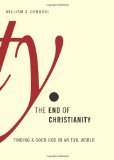Book review: The End of Christianity

 by William A. Dembski
by William A. Dembski★★★★
It took me a while to get into this book, but once I did, I was hooked. Dembski is a proponent of Intelligent Design, and has written before on that topic. His conundrum is that he also is a believer in the biblical story of Genesis—the story of the Fall is particularly troublesome—and wishes to accommodate scripture into an old earth theology. But unless one refuses to recognize the evil in nature itself, evil came before the Fall, right? Evil (defined primarily as the cause of suffering) seems designed into the world. What do we make of human suffering, and how did evil enter the world? How are we to interpret the Original Sin?
In the book, Dembski methodically debunks one young-age creationism theory after another, and he's right: It's time that evolution be accepted as a given. Evolutionary geneticist Jerry Coyne defines biological evolution as follows:
There is only one going theory of evolution, and it is this: organisms evolved gradually over time and split into different species, and the main engine of evolutionary change was natural selection. Sure, some details of these processes are unsettled, but there is no argument among biologists about the main claims.
Dembski reasons that anyone without a stake in the age of the earth is unlikely to find young earth arguments persuasive. But at the same time, he holds fast to scriptural stories in Genesis, seemingly prepared to jump through hoops to preserve his belief, and that contradiction left my head spinning. I hardly find the Genesis creation stories plausible unless—as Dembski puts it—I "have a stake" in the Bible's historicity.
So how does Dembski make sense of the creation? We have in our Bibles two distinct creation stories; Genesis 1:1-2:3 forms one, and Genesis 2:4-3:24 forms the other. Proponents of the Documentary Hypothesis (see my book review at http://www.dubiousdisciple.com/2011/03/book-review-bible-with-sources-revealed.html ) explain that the two myths were written by two different authors, and collected side by side in the Bible. Dembski proposes a different solution, suggesting that the second story can be seen as a sort of second creation; the planting of a Garden of Eden billions of years after the first creation was begun. The formation of humans occurred within that Garden, by imparting a soul; the breath of life. Whatever makes humans distinctly human (thereby separating them from the rest of the animals and infilling them with God's image) happened at the precise moment when they enter the Garden. There, in a segregated tropical paradise, where natural evil is not evident, mankind's love for God could be fairly tested. And mankind still fell, as God anticipated.
If we accept that God was able to anticipate the Fall, we can accept that God built a world to accommodate that Fall. Even though the first humans dwelt in perfect, evil-less surroundings, they still sinned, and were banished to the world prepared for them over billions of years. Thus Dembski preserves the traditional view that natural evil is a consequence of the Fall, even though God—who creates outside the boundaries of time—prepared retroactively for mankind's sin.
(click picture to buy on Amazon)
Published on May 01, 2011 07:24
No comments have been added yet.



